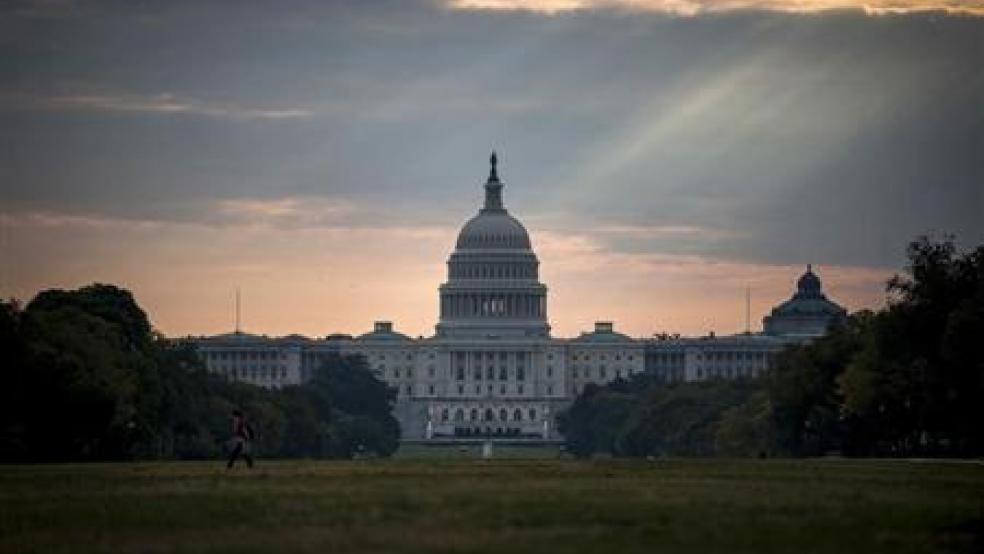As Congress prepares to leave town for another break, the Senate has been focused on the effort to confirm (or deny) Neil Gorsuch as a justice of the Supreme Court. The GOP House is desperate to show some progress on the Republican promise to repeal and replace the Affordable Care Act. But the urgent matter of making sure the federal government doesn’t have to shut down after the current Continuing Resolution under which it is authorized to spend money expires at midnight on April 28 is still on the back burner. That’s a problem because when lawmakers get back to town later this month, they aren’t going to have much time to solve a problem that has proved very tricky in the past.
Related: How Trump's Latest Twitter Tantrum Could Shut Down the Government
Where is everybody going?
Both houses of Congress are leaving town for “district work periods.” The House is leaving on what is generally referred to as a “two week” break, but at 18 days, it’s closer to three. When it returns, there are four scheduled “legislative days” before the federal government will be forced to shut down. The Senate, which doesn’t leave town until Friday, will have five legislative days to work before the federal government runs out of spending authority.
What is expiring?
Congress never managed to pass the spending bills necessary to authorize the departments of the executive branch to pay their bills and their employees’ salaries for Fiscal 2017, so since last fall, the government has been operating under a “Continuing Resolution” that allows spending set, for the most part, at levels established a year before.
That CR, as it is called, was renewed in December of last year, with an expiration date of April 28. At the time, then-Appropriations Committee Chair Hal Rogers said, “[T]his type of short-term spending absolutely should not be the final answer to funding the federal government for the year. It is imperative that Congress complete its work on the remaining 11 Appropriations bills to ensure the proper and responsible use of tax dollars, to provide necessary resources for important programs and services, and to hold federal agencies accountable to the American people.”
Related: Why Another Government Shutdown Is Suddenly in the Cards
Spoiler alert: It never happened.
What happens if the CR expires?
The Constitution of the United States is pretty explicit on the topic. Article I, Section 9 says “No money shall be drawn from the Treasury, but in consequence of appropriations made by law.” In other words, if there is no appropriation passed by Congress, it is generally illegal for the executive branch to spend money. That means that any government agency funded through the appropriations process -- and that’s most of them -- must shut down. An exception is made for people and offices that are deemed essential to protecting “the safety of human life or the protection of property.”
If the government shuts down, most federal employees would be allowed into the office briefly on the next workday to prepare for an orderly shutdown, but would afterward be barred from their places of employment until the shutdown ends.
Then what?
It’s important to note that April 28 is a Friday, so by midnight on that day, most federal employees will have started their weekend, effectively giving Congress an extra two days before the full effects of the shutdown become apparent to most Americans.
However, that’s no guarantee that there will be a speedy resolution. A dozen shutdowns dating back to the Reagan administration averaged five days in length, with many resolved in a single day. However, the last two -- under Presidents Bill Clinton and Barack Obama, lasted 21 and 16 days, respectively.
Related: How Trump and the GOP Are Handing Congress Back to the Democrats
Congress will eventually have to come to some sort of agreement to allow the government to continue spending money, but what that will look like is anybody’s guess.
The simplest method would be to authorize another CR, keeping spending locked at its current levels. But influential members of Congress, like Arizona Sen. John McCain, have promised to fight for a full year funding plan so that the armed forces can take advantage of proposed budget increases.
Another potential stumbling block is that more extreme members of Congress recognize that their leverage is greatly magnified in a crisis, and have in the past used moments like this to make extraordinary demands to secure their votes. Must-pass legislation like debt ceiling increases and appropriations bills have often been subject to attempts to tie them to things like defunding of the Affordable Care Act or making Planned Parenthood ineligible for federal funds.
When will we know if a shutdown is coming?
Shutdown negotiations are, almost by definition, an exercise in political brinkmanship, so it will be no surprise of there is no resolution reached until late on the 28th or, given the buffer of the weekend, sometime before federal workers would be expected to show up on the following Monday morning.
As House members were getting ready to leave on Friday, Democratic leader Nancy Pelosi said that there were ongoing negotiations among the members of the Appropriations Committees. However, she told reporters, a daunting number of issues remained to resolve.
“The number I know is 115,” Pelosi said, according to The Hill. “It went from 200 to 115, and now we’ll see.”





